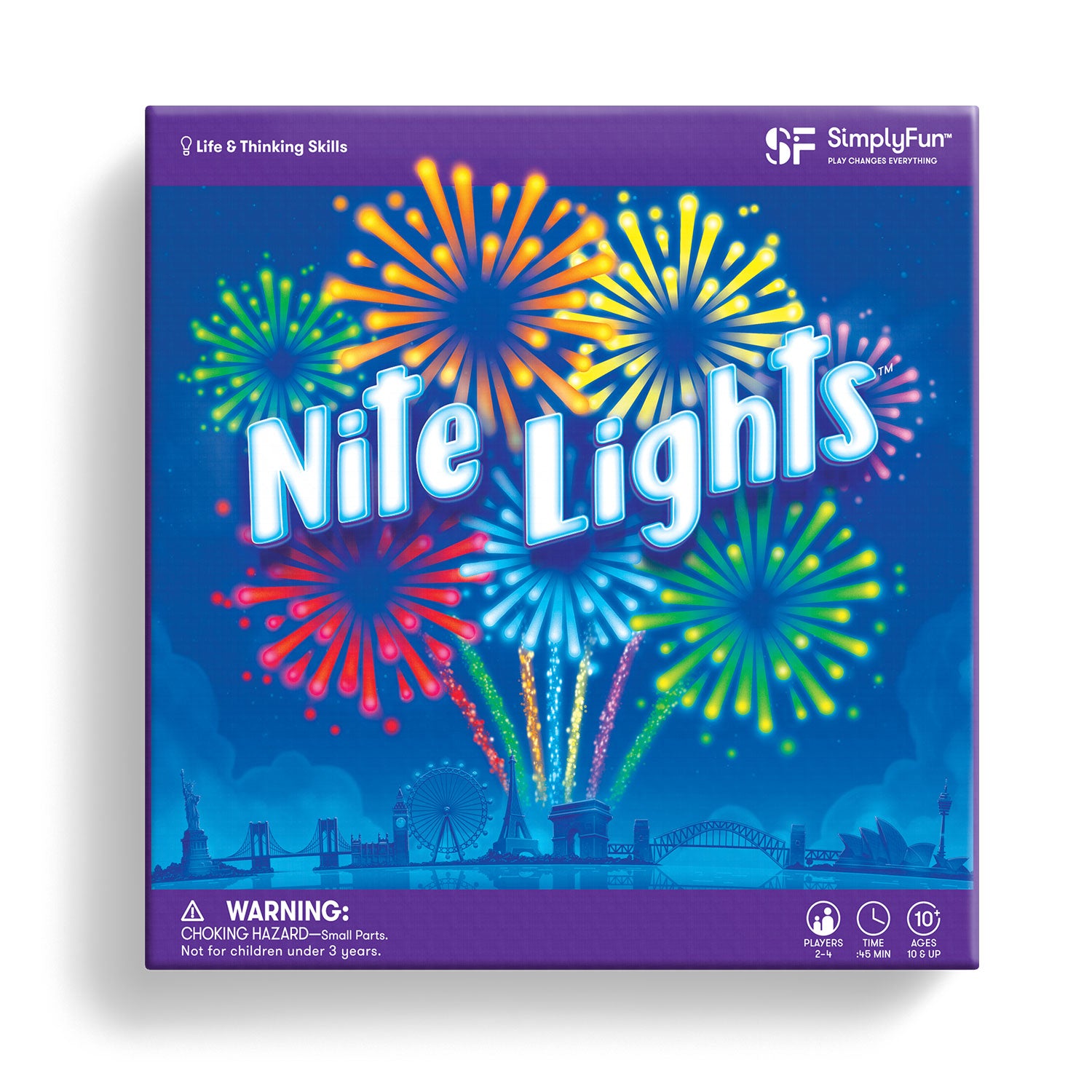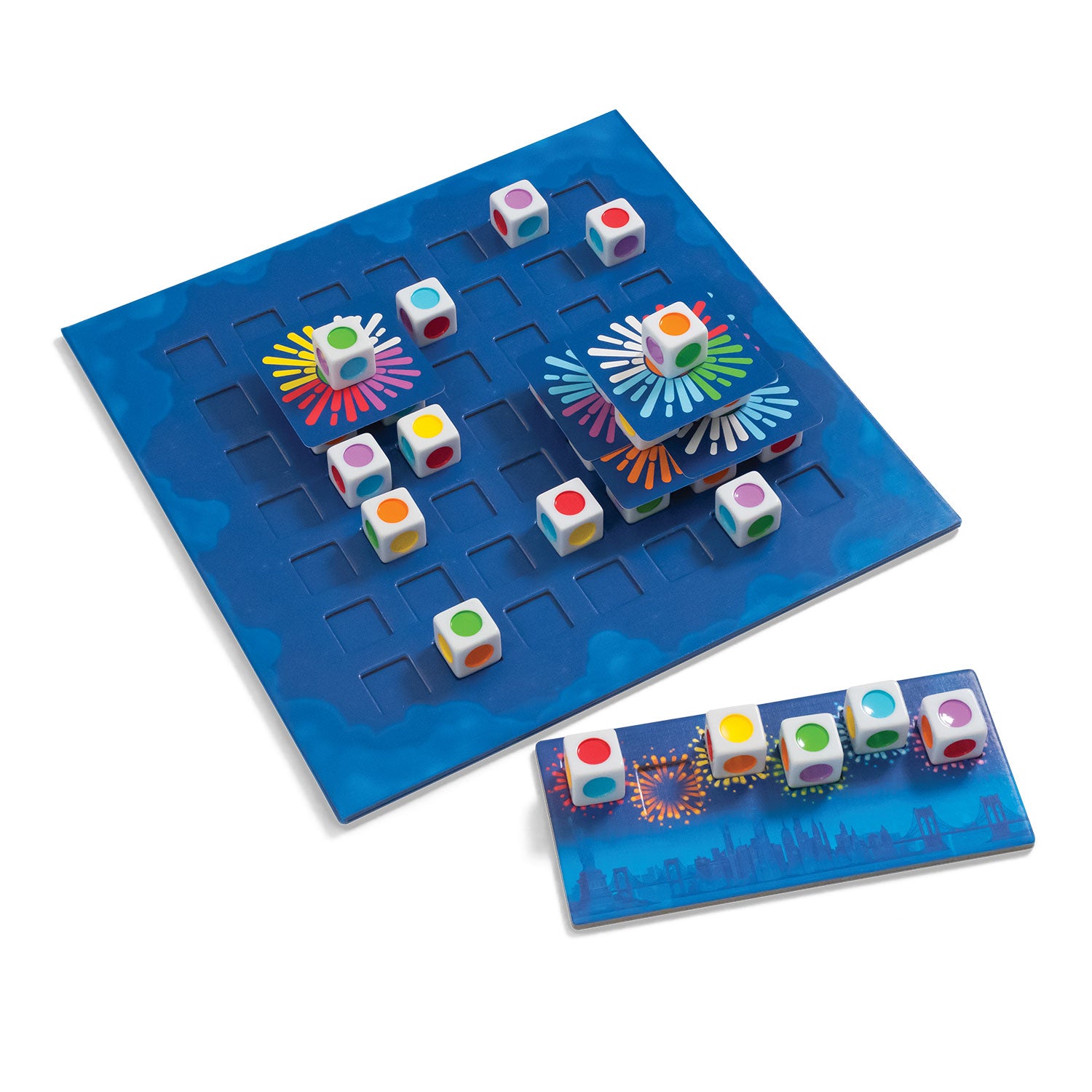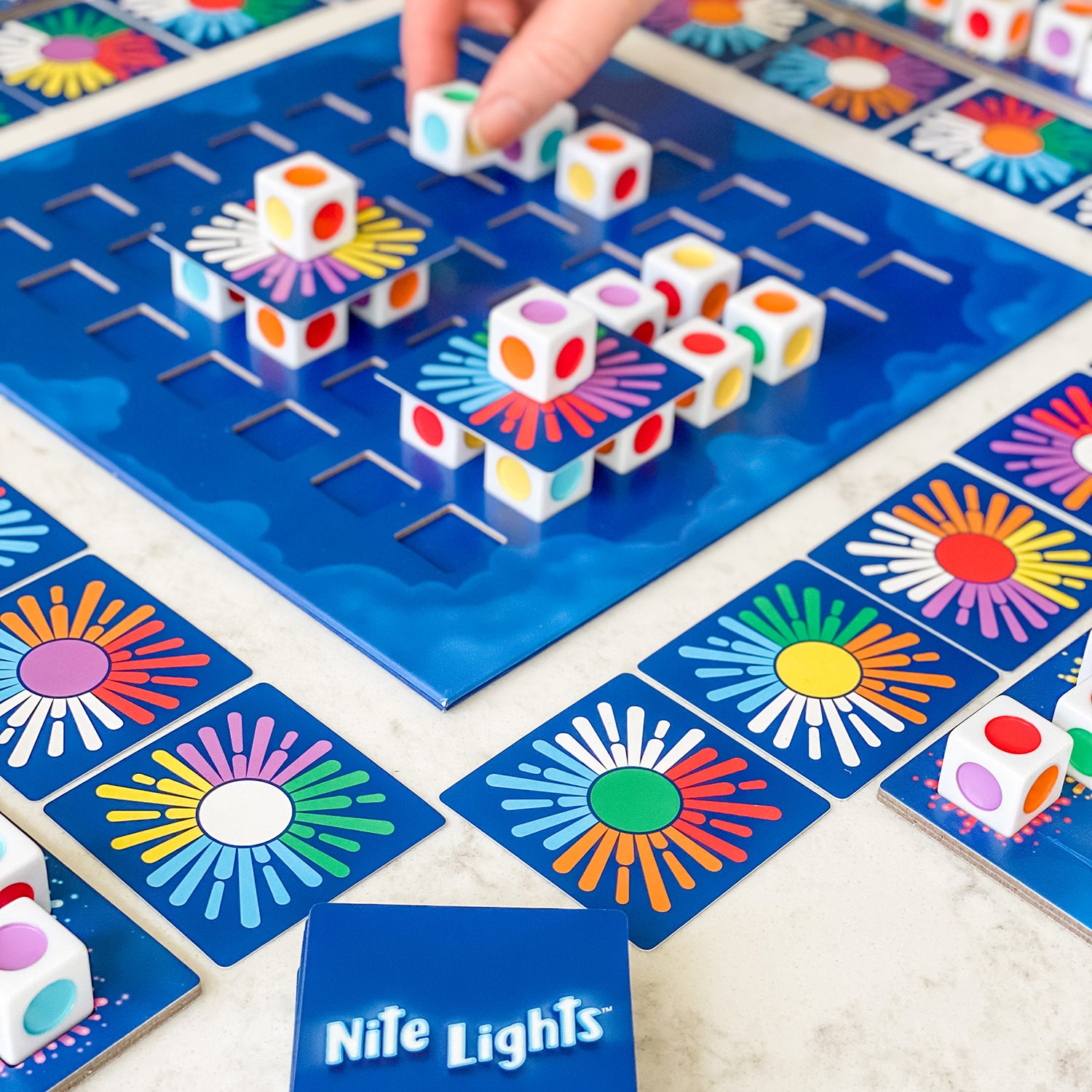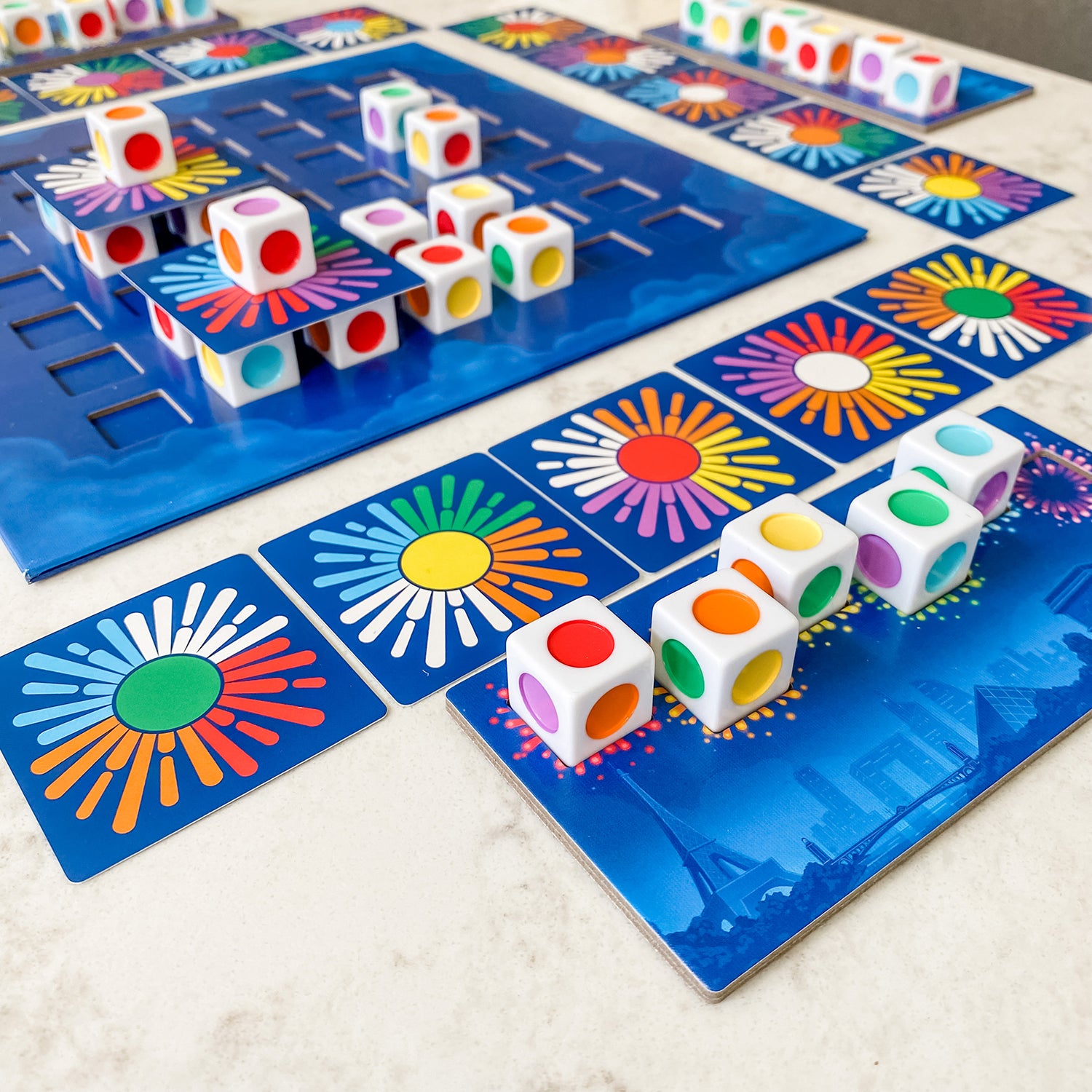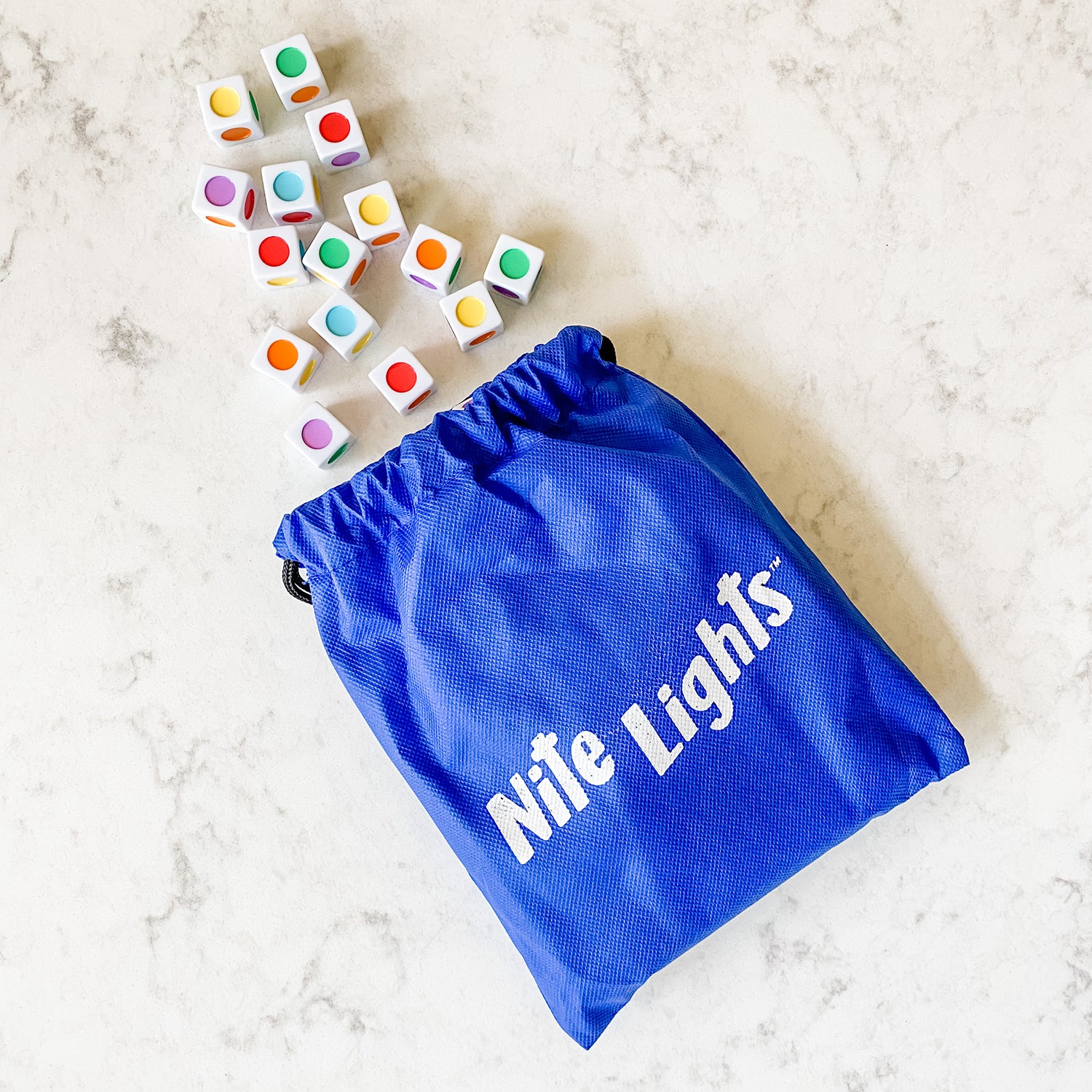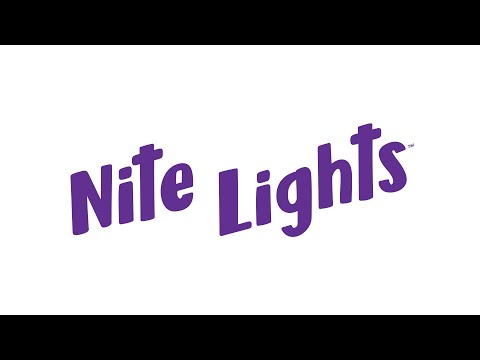Nite Lights
Nite Lights
2-4 players • 45 min • 10 & up
Focus: Strategy
Couldn't load pickup availability
Players light up the sky, stacking their firework cards and blocks on the board by creating and matching color patterns. The first player to send all six of their Show Blocks into the night sky wins.
Skills: Spatial Reasoning, Strategy
Game Includes
Game Includes
- 80 Blocks
- 4 Skyline Boards
- 60 Fireworks Cards
- 1 Cloth Bag
- 1 Gameboard
- 1 Rules Booklet
Share
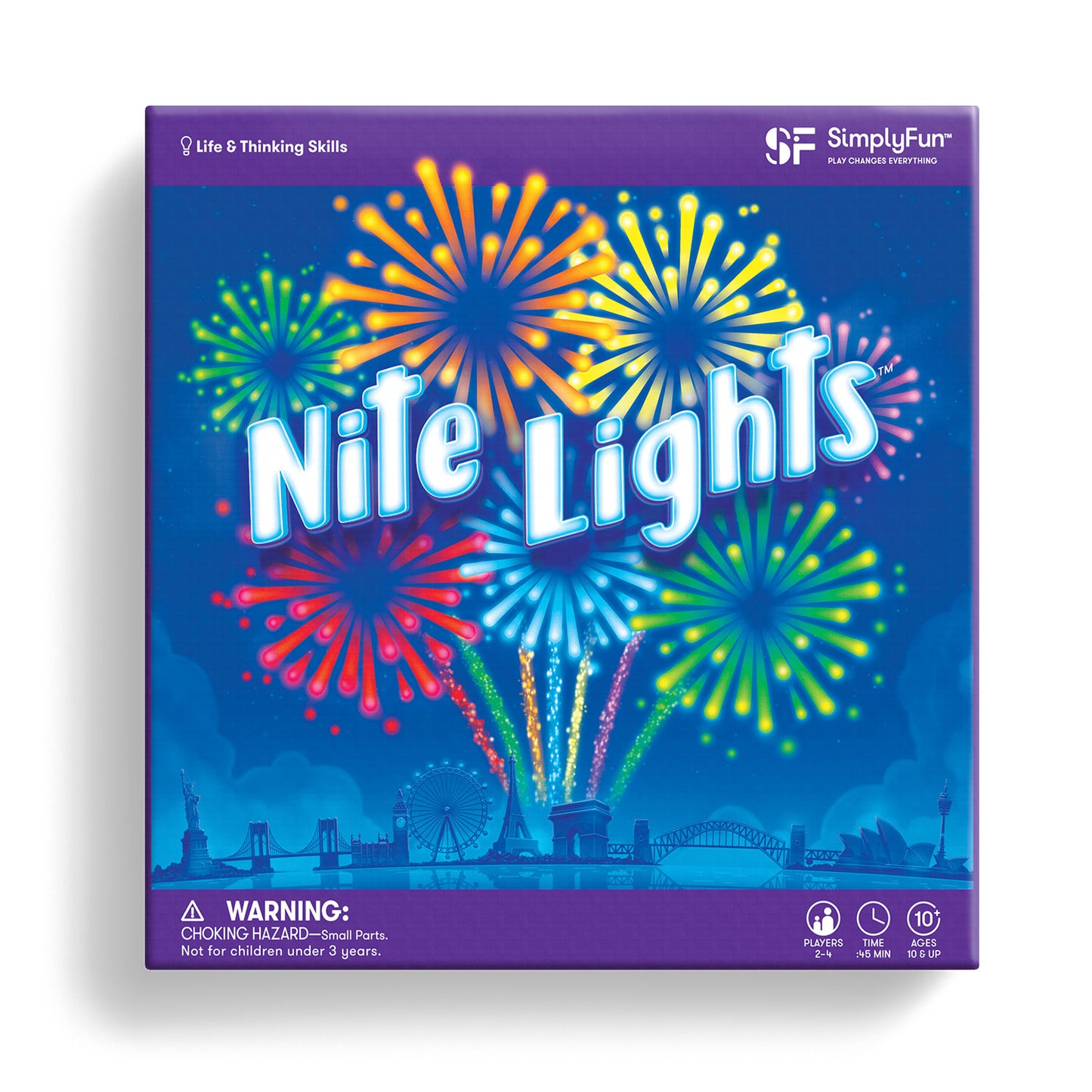
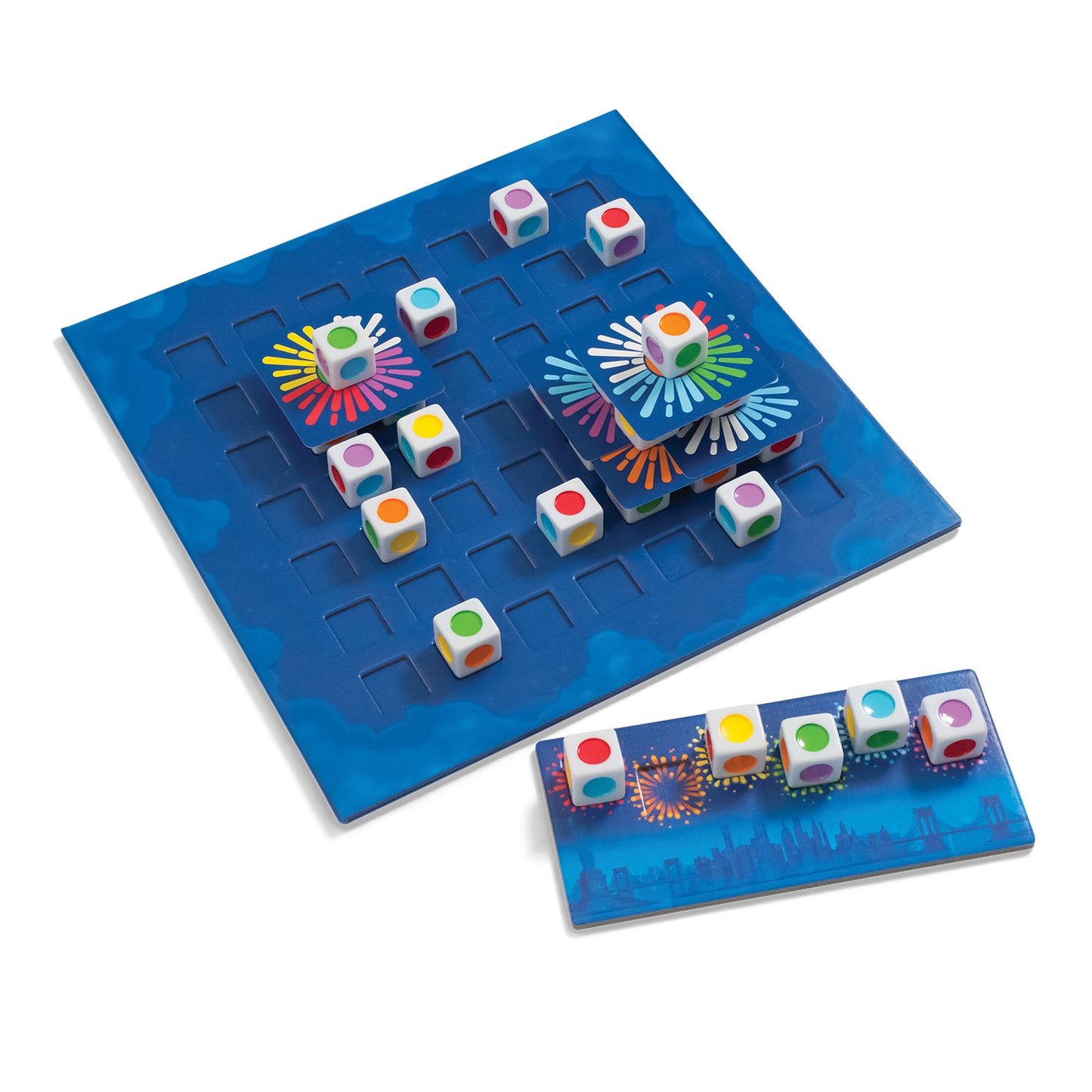
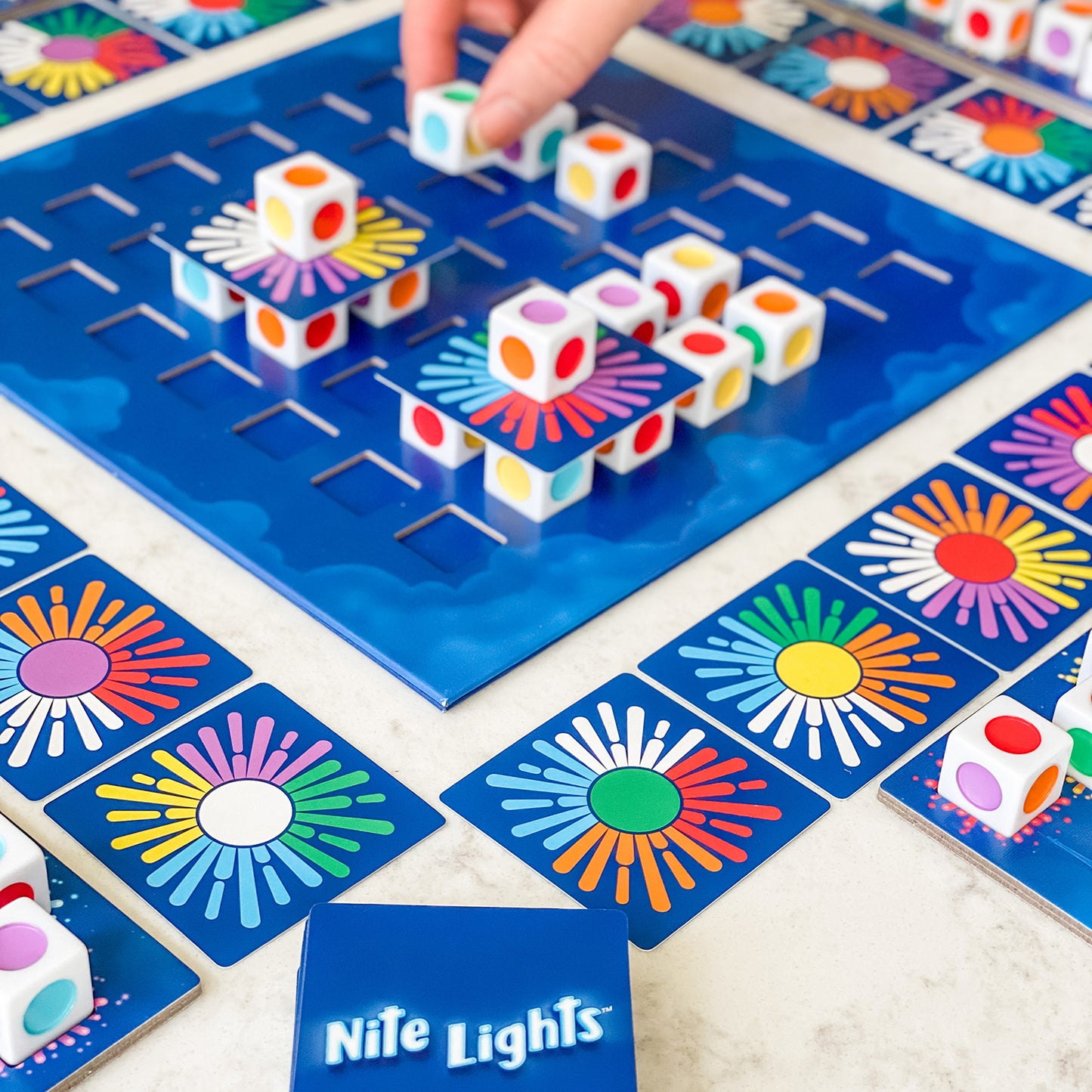
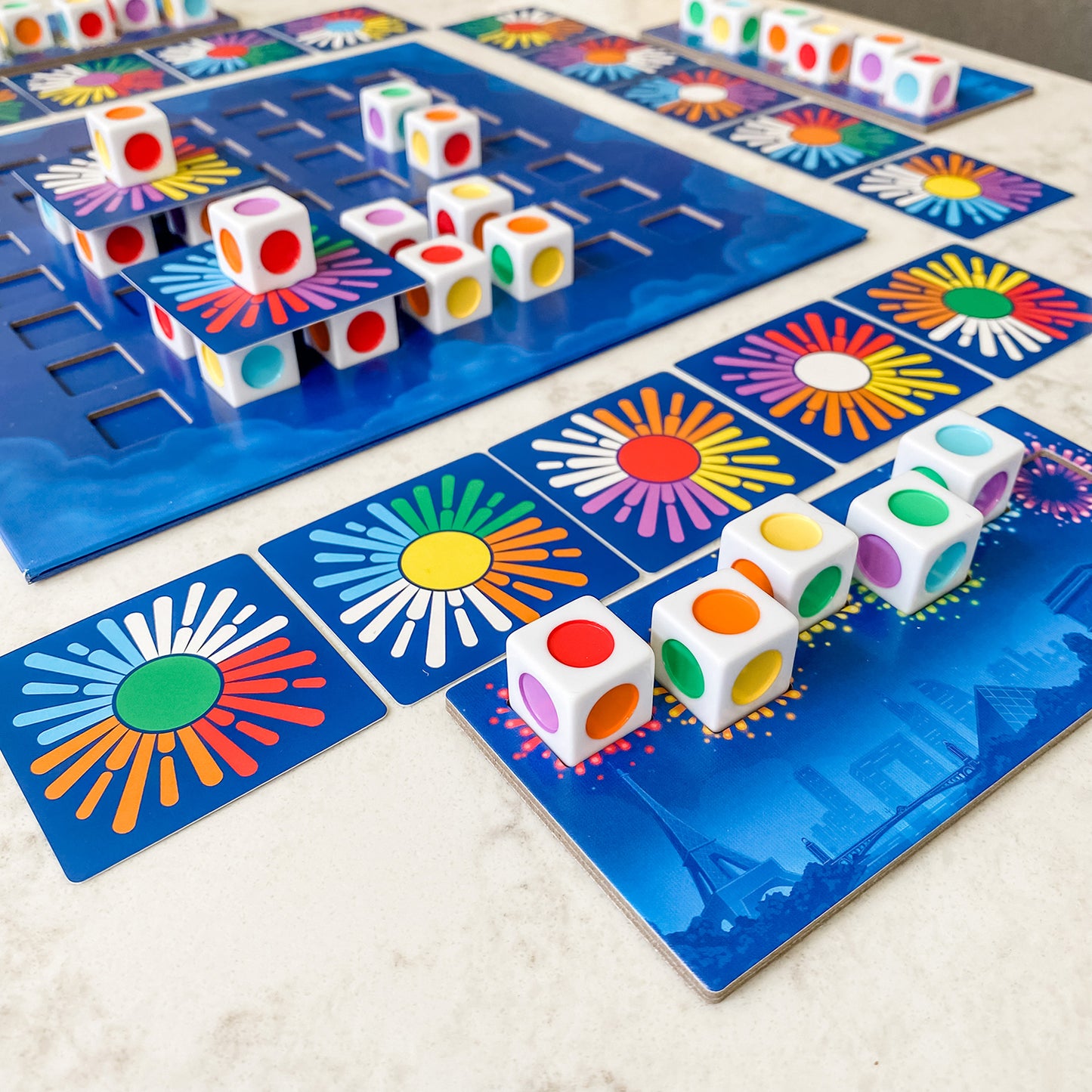
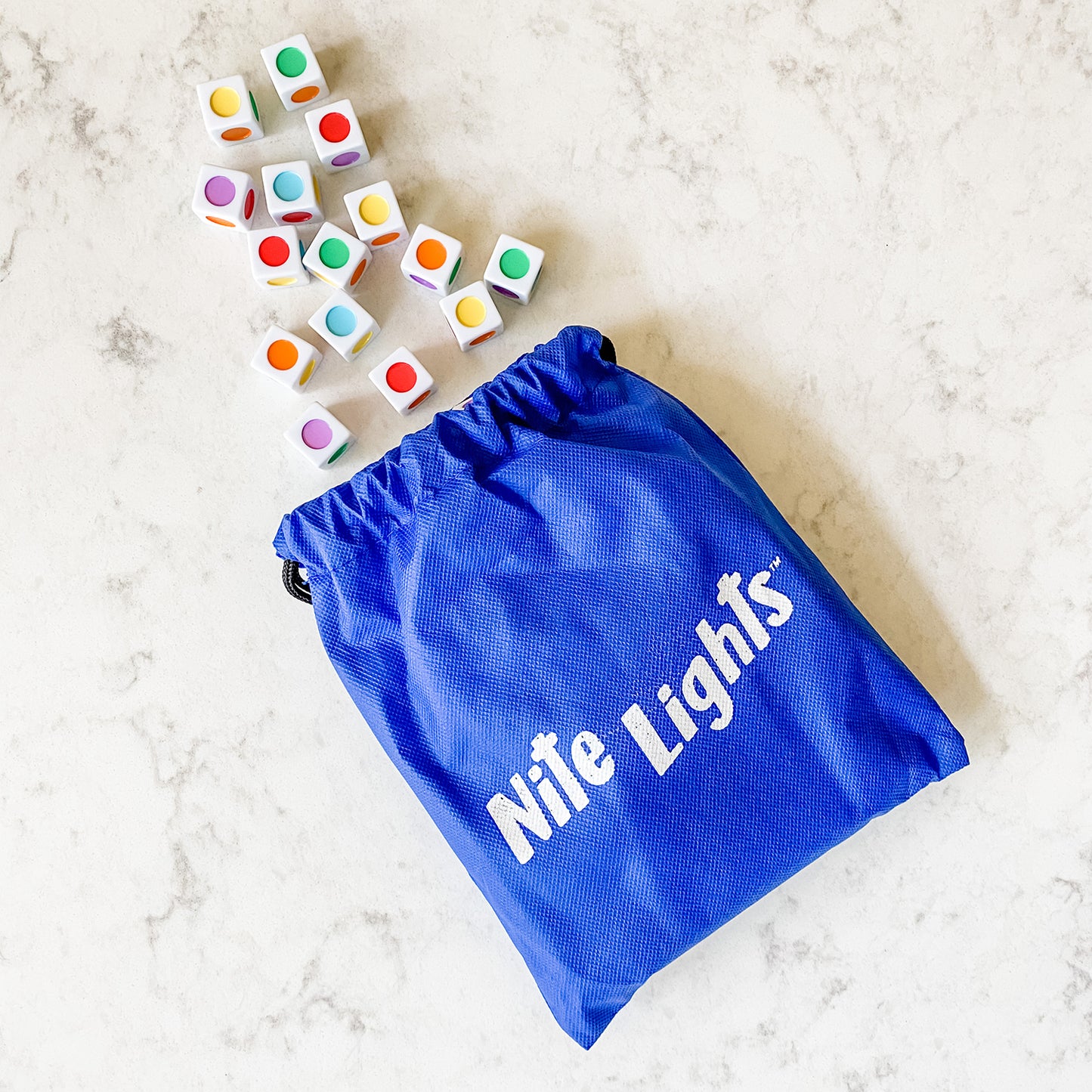

Collapsible content
How to Play
Educational Standards
Core Standard*: Math
Math
- Mathematical Practice
- Make sense of problems and persevere in solving them. Grade Levels 5th, 6th, 7th
Skills
Explore
What Does Child Do To Use Skill In The Game?
In order to do well in the game, players need to look carefully at all of the firework cards and blocks on the gameboard, other peoples' firework cards, and their own firework cards and blocks.
How Parents Can Assist Learning
Encourage children to rotate their firework cards and hold them over the gameboard to help them look for possible moves for playing one of their firework cards.
Learning Implications and Educator Support
Careful examination of the game board and the firework cards and blocks of opponents is essential to the analytical and strategic thinking skills required in Nite Lights.
Encourage children to rotate their firework cards and hold them over the gameboard to help them look for possible moves for playing one of their firework cards.
Determine
What Does Child Do To Use Skill In The Game?
On each turn, players look for options for creating 4-color block combinations that would allow the player to place a firework card on the gameboard.
They may also look for opportunities for rotating a block on the gameboard in order to thwart another player's effort to play their firework cards.
How Parents Can Assist Learning
Nite Lights helps develop observational, visual spatial and association skills.
Encourage children to rotate their firework cards and hold them over the gameboard to help them look for possible moves for playing one of their firework cards.
Additionally, when first learning to play, children may need to be reminded to look at the color of the circle center of their firework cards and the colors of the blocks on their skyline board. Otherwise, they may successfully create 4-color combinations that allow them to play a firework card, but that card does not allow them to play one of their blocks. Since the goal of the game is to play all of your blocks, it is important to try to play firework cards that allow you to play a block at the same time.
Learning Implications and Educator Support
Nite Lights helps develop observational, visual spatial and association skills.
Encourage children to rotate their firework cards and hold them over the gameboard to help them look for possible moves for playing one of their firework cards.
Additionally, when first learning to play, children may need to be reminded to look at the color of the circle center of their firework cards and the colors of the blocks on their skyline board. Otherwise, they may successfully create 4-color combinations that allow them to play a firework card, but that card does not allow them to play one of their blocks. Since the goal of the game is to play all of your blocks, it is important to try to play firework cards that allow you to play a block at the same time.
Compare
What Does Child Do To Use Skill In The Game?
Nite Lights involves a lot of comparison as players look at the colors of all the blocks and firework cards on the game board, the color patterns on other players' cards, and the colors on their own firework cards and blocks.
How Parents Can Assist Learning
Nite Lights is good for developing flexible thinking and spatial reasoning skills because children need to consider multiple variables, namely, firework color patterns, center circle colors, colors and orientation of all blocks on the gameboard, and colors of the remaining blocks on their skyline boards.
Learning Implications and Educator Support
Nite Lights is good for developing flexible thinking and spatial reasoning skills because children need to consider multiple variables, namely, firework color patterns, center circle colors, colors and orientation of all blocks on the gameboard, and colors of the remaining blocks on their skyline boards.
Predict
What Does Child Do To Use Skill In The Game?
Players will try to predict what others will play based on their firework cards and prior moves they have made.
How Parents Can Assist Learning
To be successful in Nite Lights, children would greatly benefit if they pay close attention to the moves of other players, as well as the firework cards and blocks of those players. They also will benefit from thinking about what other players may do based the move they make on this turn.
To help children evaluate different options, encourage them to "Wait. Look. Think." This will help them spend time considering different moves and the consequences of those moves, which is needed for making higher quality prediction
This will also help with impulsivity and planning. Using such verbal cues can give children a model for approaching future play.
Learning Implications and Educator Support
Predicting involves skills like analysis, observation, empathy and interpretation.
Educators can prompt children to practice predicting by asking questions like "what firework card to you think your opponent wants to play on her next turn?" or "Why do you think that player rotated a block on his turn?"
Plan
What Does Child Do To Use Skill In The Game?
Players will try to plan for future moves, however, they will often need to adapt to the moves of opponents which obstruct the original plan.
How Parents Can Assist Learning
Thinking about future moves can help children win Nite Lights. Parents can remind children to think about what could happen next if they play a certain firework card, place a block in a certain location or rotate a block to change it's color. This type of long-term, sequential thinking is important well beyond game play.
Learning Implications and Educator Support
Nite Lights is a good game for helping children develop organizational skills as they plan moves, and adaptive skills as they creatively respond to moves of opponents. Organizing is essential to effective planning and is an important executive functioning skill.
Thinking about future moves can help children win the game. Educators can remind children to think about what could happen next if they play a certain firework card, place a block in a certain location or rotate a block to change it's color. This type of long-term, sequential thinking is important well beyond game play.
Experiment
What Does Child Do To Use Skill In The Game?
Players may experiment with offensive strategies, i.e. to create opportunities to play their firework cards and blocks, and defensive strategies, i.e. to prevent others from playing their firework cards and blocks by strategically placing or rotating blocks on the gameboard.
How Parents Can Assist Learning
Nite Lights is good for experimenting with strategy and tactics. Discuss different strategies prior to starting the game and encourage the child to select one. Play the game and discuss. Then, play again with the child trying a different strategy. Discuss again and compare the advantages and disadvantages.
Learning Implications and Educator Support
Nite Lights is good for experimenting with strategy and tactics. Discuss different strategies prior to starting the game and encourage the child to select one. Play the game and discuss. Then, play again with the child trying a different strategy. Discuss again and compare the advantages and disadvantages.
Practice
What Does Child Do To Use Skill In The Game?
The more children play Nite Lights, the more they will develop increasing sophisticated strategic, spatial reasoning and analytical skills.
How Parents Can Assist Learning
Parents can encourage children to practice in order to master strategic elements of the game.
Learning Implications and Educator Support
Educators can encourage children to practice in order to master strategic elements of the game.
Solve
What Does Child Do To Use Skill In The Game?
Players need to consider and adapt to the moves of other players in order to ultimately win the game.
How Parents Can Assist Learning
Children learn new information constantly during game play. This information directly effects how children strategize an approach for placing and rotating blocks, placing firework cards, and ultimately solving the game.
This fundamental ability to shift strategies based on new information is a great life skill that can help children cope with the stresses of change in other areas of their life.
Learning Implications and Educator Support
Nite Lights involves uses of spatial reasoning, analysis, pattern recognition and if/then problem solving. Children learn new information constantly during game play. This information directly effects how children strategize an approach for placing and rotating blocks, placing firework cards, and ultimately solving the game.
*Data compiled from CCSSI ELA Standards, WA Science Standards, and Washington Social Studies Standards
Special Needs
Cognitive
Suggestions for How to Modify Play Experience
Reduce the number of Firework Cards to three and the number of Show Blocks to three. This reduces the number of cards the child must compare. It also reduces the time of the game so attention is maintained.
Eliminate building tiers of cards. This simplifies the game by allowing the child to focus on only one set of patterns. In addition, the first player to place 4 of their blocks on the gameboard wins.
Deal the player with cognitive challenges only cards that have white "wild card" sections or a white center. This will allow the player to more easily make matches.
Communication
Suggestions for How to Modify Play Experience
Communication is not necessary in the game, but should be encouraged. Encourage players to name the color matches they made.
Sensorimotor
Suggestions for How to Modify Play Experience
Play with a partner who is able to make the placement of the die and the cards onto the board. Players can jointly discuss which card to play and where on the board.
Nite Lights will be challenging for a player with fine motor difficulties to play without a partner.
Social Emotional/Behavioral
Suggestions for How to Modify Play Experience
Nite Lights may be frustrating for children who have low tolerance for being blocked from their goals. For these children, it may be helpful to eliminate the ability to rotate a die on the board, at least while learning the game. Once the child gains confidence, introduce the dice rotation by demonstrating how this can be done with another player's die first.
Eliminate the Show Blocks. Modify Nite Lights so that the winner is the first player to play 10 cards by matching color patterns of other cards on the gameboard. Use a pencil and paper to keep score of each card match. This reduces stress by allowing players to concentrate on matching the card patterns, rather than having to also think about playing their Show Dice.
Vision
Suggestions for How to Modify Play Experience
Nite Lights is not appropriate for children with vision challenges.
Hearing
Suggestions for How to Modify Play Experience
Players with hearing impairments should not need modifications to play Nite Lights.
*Data compiled from CCSSI ELA Standards, WA Science Standards, and Washington Social Studies Standards
Autism
Autism Strengths & Interests
Short Summary of Strengths & Interests
- Visual spatial reasoning
- Analytical thinking
- Matching
Is good at matching visual items
Is This Game Appropriate? Yes
Description
Nite Lights is primarily a matching game, but with various levels of matching and analytical thinking required.
Has a good memory for sensory details, including visual, touch, taste and smell
This game is not appropriate
Has a good memory for words, phrases and dialouge
This game is not appropriate
Has a good memory for pictures, numbers and patterns
This game is not appropriate
Likes to put things in order or a sequence
Is This Game Appropriate? Yes
Description
Players need to rotate their cards to look for a visual match between the blocks and Firework cards on the board to one of their own Firework Cards. They also have to place blocks on the board in order to match a sequence on a Firework Card in their hand.
Learns through visualizing or "replaying" actions in their mind
This game is not appropriate
Likes activities with rules, such as math and phonics
This game is not appropriate
Is very concrete and literal
Is This Game Appropriate? No
Description
Although the matching of patterns is concrete, players need to think abstractly to analyze potential placement of blocks on the board.
Learns in small "chunks" (for example, phone numbers are 3 chunks of number xxx-xxx-xxxx that are combined together)
This game is not appropriate
Is good at nonverbal reasoning and logic
Is This Game Appropriate? Yes
Description
Nite Lights requires players to use nonverbal reasoning to determine where to place blocks on the board or when to turn another player's block. Players need to think both offensively and defensively.
Likes spatial problem solving
Is This Game Appropriate? Yes
Description
Placement of both blocks on the board and Firework Cards on top of the blocks requires players to use spatial reasoning.
Can read well with good vocabulary, though may not fully comprehend content
This game is not appropriate
Likes to use and has good fine motor skill
Is This Game Appropriate? Yes
Description
The placement of blocks and Firework Cards on the board requires fine motor precision, especially as players begin to overlap cards and build higher levels of blocks. This game is not appropriate
Likes established routines or set ways of doing things
This game is not appropriate
Likes manipulating, constructing or building things
This game is not appropriate
Likes to use and has good musical abilities
This game is not appropriate
Likes to use and has good drawing skills
This game is not appropriate
Autism Special Considerations
Appears to ignore other's communication and/or has difficulty giving eye contact to a communication partner
Is This Game Appropriate for Child with Characteristic? Yes
Can Child with Characteristic Play Game w/o Modification? Yes
Strategies for Developing Compensatory Skills:
Nite Lights does not require communication or eye gaze for a player to do well in the game.
Has difficulty understanding complex verbal directions
Is This Game Appropriate for Child with Characteristic? Yes
Can Child with Characteristic Play Game w/o Modification? No
Strategies for Developing Compensatory Skills:
The directions to Nite Lights are complex, but spending time demonstrating the various aspects of the game can allow children to learn the game.
Uses vocabulary inaccurately or demonstrates echolalia (repeating another's speech)
Is This Game Appropriate for Child with Characteristic? Yes
Can Child with Characteristic Play Game w/o Modification? Yes
Strategies for Developing Compensatory Skills:
There is not a lot of discussion required in playing Nite Lights, so echolalia may not be a concern. Players may want to keep discussion related to the game. This will help children use their echolalia in a productive way to understand the game. However, if players prefer to talk during gameplay, echolalia could become distracting.
Gets stuck repeating a verbal topic or physical actions and/or has difficulty attending to others' actions or topic.
Is This Game Appropriate for Child with Characteristic? No
Can Child with Characteristic Play Game w/o Modification? No
Strategies for Developing Compensatory Skills:
Nite Lights requires focused attention. Children who have obsessive talk or actions may inhibit other players attention to the game. Unless other players can ignore these behaviors, the game may be less enjoyable.
Has difficulty producing speech/communication
Is This Game Appropriate for Child with Characteristic? Yes
Can Child with Characteristic Play Game w/o Modification? Yes
Strategies for Developing Compensatory Skills:
Discussion is not needed during the game, though players may want to discuss their moves. The gameplay discussion may benefit the child with reduced verbal skills, particularly if language comprehension is good. Some children understand more than they can express verbally, so player discussion may help the child learn the game.
Has difficulty sequencing multi-step actions and/or doing complex abstract tasks
Is This Game Appropriate for Child with Characteristic? No
Can Child with Characteristic Play Game w/o Modification? No
Strategies for Developing Compensatory Skills:
Nite Lights requires thinking about multiple steps and planning ahead for future moves. It also requires players to watch and interpret other players thinking and actions. For this reason, the game may be too challenging for some children with autism.
Demonstrates difficulty initiating and maintaining social interactions
Is This Game Appropriate for Child with Characteristic? Yes
Can Child with Characteristic Play Game w/o Modification? Yes
Strategies for Developing Compensatory Skills:
Players do not need to initiate or maintain social interactions in Nite Lights. Focus on the game and game board is sufficient for successful play.
Acts out or demonstrates avoidance behaviors when frustrated, overwhelmed, or needs more sensory input.
Is This Game Appropriate for Child with Characteristic? No
Can Child with Characteristic Play Game w/o Modification? No
Strategies for Developing Compensatory Skills:
Nite Lights can be frustrating when a players intended play is thwarted by another player turning a block or placing a card on another player's intended board spot. To help children who may get frustrated, see modifications for Special Needs: Emotional and Social considerations for recommended options for play.
Has short attention span for non-preferred activities
Is This Game Appropriate for Child with Characteristic? Yes
Can Child with Characteristic Play Game w/o Modification? Yes
Strategies for Developing Compensatory Skills:
If visual matching, visual spatial reasoning, and pattern analysis games are a preference, Nite Lites is a good choice. If this is not a preference, other games may be more appropriate.
Needs sameness or consistent routines and/or has difficulty with transitions from one activity to another
Is This Game Appropriate for Child with Characteristic? Yes
Can Child with Characteristic Play Game w/o Modification? Yes
Strategies for Developing Compensatory Skills:
Players may be transitioned to the game by using the Fireworks Cards and Blocks to remind the child of the fun of playing the game. Often using such object reminders can provide incentive to transition to the new activity.
Has difficulty understanding others' feelings, intentions, and the reasons for others' actions.
Is This Game Appropriate for Child with Characteristic? Yes
Can Child with Characteristic Play Game w/o Modification? Yes
Strategies for Developing Compensatory Skills:
Although one aspect of Nite Lights is analyzing other players cards and anticipating their moves, this aspect can be removed by having players hold their cards and only look at other players' move by looking at the board.
*Data compiled from CCSSI ELA Standards, WA Science Standards, and Washington Social Studies Standards
Extended Play
Extra Ways to Play the Game
Play Nite Lights with cards held in players hands so they are not visible to the other players. This eliminates the need to analyze and compare the firework cards of other players on your turn.
Materials Needed
No additional materials needed.
Developmental Benefits
Analyzing your own and other players cards takes time and may be difficult or stressful for some children. This modification enables players to concentrate on comparing just their own hand of cards with the patterns on the board.
Extra Ways to Play the Game
Set the gameboard up by placing 10-20 blocks randomly around the board and then start playing.
Materials Needed
No additional materials needed.
Developmental Benefits
This expansion adds a different element of analysis, as players can choose from many possible options on the board. They can also potentially plan for a sequence of plays to connect blocks on the board. It also can speed up the game, if that is desired.
*Data compiled from CCSSI ELA Standards, WA Science Standards, and Washington Social Studies Standards
Collapsible content
How to Play Video & Transcript
You can play Nite Lights with 2-4 players, ages 10 and up.
Nite Lights is good for developing Spatial Reasoning skills as players analyze color patterns on the board by finding or creating opportunities to place their cards.
Nite Lights also helps with Strategy skills as players determine where to set their block piece or which block to rotate while trying to match the patterns on their cards or obstruct an opponent’s match.
Place the gameboard in the center of the play area within reach of all players.
Give each player a Skyline Board of their choice and six blocks from the bag. Set the blocks in the corresponding spaces with one of each color faceup.
These are your Show Blocks.
Shuffle the Firework Cards and deal five cards to each player. Cards should be laid faceup in front of each player, so everyone can see them. Set the remaining cards to the side of the gameboard facedown. This is the draw pile.
Place the bag with the remaining blocks within reach of all players. This is the draw bag.
Players stack their Firework Cards and blocks on the board by creating and matching color patterns. The first player to place all six of their Show Blocks onto the board wins.
Each Firework Card consists of a circle in the center surrounded by four sections. Use the color sections to place the cards on matching color patterns created by blocks and other cards on the gameboard.
The center circle indicates which color Show Block to set on top of that card.
WILDS
There are two types of wilds found on the cards – white sections and white circles.
A white section may be placed on (or matched to) any color block or card section.
A white circle may have any color Show Block set in the center of the card.
The first player starts by taking a block from the draw bag and placing it anywhere on the board, showing the color of their choice. Play then continues clockwise.
(it will take a few rounds before anyone has an opportunity to place a card)
BLOCKS
On your turn, choose to either place a new block from the draw bag onto the gameboard or rotate a block (change the color facing up) that is already on the gameboard.
Rotating any block that was just placed or rotated by the previous player is not allowed.
FIREWORK CARDS
After you have placed or rotated a block, look for a pattern that matches the four, color sections on one of your cards. If a pattern exists, you may place your card on top of the coordinating colors.
You may need to rotate the card’s orientation in order to match a pattern on the gameboard.
Once you place a card, set one of your Show Blocks on to the center circle. Then draw a new card so you always have five Firework Cards in front of you.
If you are unable to place one of your Firework Cards, your turn ends, and play continues clockwise.
SHOW BLOCKS
The center of each Firework Card indicates the color of the Show Block that must be set on the card. If you have placed a card on the board, you now take the corresponding Show Block from your Skyline Board and set it in the center of that card.
If the center of the Firework Card is white, you may place any color Show Block on top of the card.
If you do not have a Show Block with the matching color on your Skyline Board anymore, take one of the blocks from the draw bag to set on top of the card that matches the circle color.
Keep an eye on your opponents’ cards, as you may want to prevent them from being able to place a Show Block. Remember the first player to get rid of all their Show Blocks is the winner.
Additional examples of placing a Firework Card on patterns
Cards may overlap with other cards already on the gameboard, and you may be able to place a card on a matching pattern that is formed by both blocks and cards.
Here are a few examples:
You may place a card that matches a pattern created by a card and two blocks. These two, color sections of a card and the two adjacent blocks match the pattern on this card. So, you can place your card so that it overlaps half of the card that is already on the board and on top of the two blocks.
A card cannot be placed by only matching its center circle to a block.
You may also place a card matching a pattern created by two overlapping cards and one block. This corner configuration of stacked cards and the one block match the pattern on this card. You can place your card so that it overlaps both cards and on top of the block.
The four colors of a matching pattern cannot be on different levels when placing a card.
You may also match one of your cards to patterns created by only cards (no blocks) Any four colors on the gameboard can be matched with the correct card. The card shown matches these four colors on the gameboard, so your card may be placed here and as with any other card placement, you now place the corresponding Show Block in the center of the card.
To ensure a stable level, a card cannot be placed by only partially covering blocks in a matching pattern.
NOTE: When placing a card that overlaps other cards on the gameboard, you may need to temporarily lift any blocks that are in the way. Once the new card is placed, return the blocks to their original location.
If you placed a card on level one, your turn ends by setting the Show Block on top of that card. Even if you could place another card as a result, this is not allowed.
However, if you placed a card on level two or higher, you can take one extra turn, repeating Actions 1-3. Therefore, you might be able to set another one of your Show Blocks on the same turn.
The first player to send all six of their Show Blocks into the night sky has put on the best firework show and wins the game!
Have fun building a dazzling firework show for everyone to enjoy as you celebrate playing Nite Lights!!
- Choosing a selection results in a full page refresh.
- Opens in a new window.

